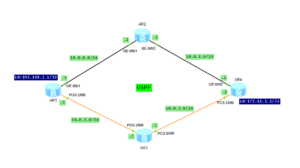What do we have in traditional IP networks?
Let’s assume that there is a fault at the physical or data link layers. Router sees that a physical interface becomes DOWN. After the router detects this fault, it informs upper layer routing system to update routing information. The convergence time is several seconds, what is critical for sensitive services.
That’s why IP FRR has been developed. After we configure IP FRR, a router doesn’t wait for network convergence but a backup link is immediately used to forward packets.
We have 2 scenarios of using IP FRR:
- To protect routers in public networks.
- To protect CE routers in private networks.
Let’s focus on the first one.
I am using OSPF protocol to allow routers to learn routes from each other. Because of greater OSPF cost on POS links, traffic from AR1 to AR4 is forwarding through AR2:
[AR1]dis ip rout
Route Flags: R - relay, D - download to fib
------------------------------------------------------------------------------
Routing Tables: Public
Destinations : 15 Routes : 15
Destination/Mask Proto Pre Cost Flags NextHop Interface
10.0.0.0/24 Direct 0 0 D 10.0.0.1 GigabitEthernet0/0/1
10.0.0.1/32 Direct 0 0 D 127.0.0.1 GigabitEthernet0/0/1
10.0.0.255/32 Direct 0 0 D 127.0.0.1 GigabitEthernet0/0/1
10.0.1.0/24 OSPF 10 2 D 10.0.0.2 GigabitEthernet0/0/1
10.0.2.0/24 Direct 0 0 D 10.0.2.1 Pos2/0/0
10.0.2.1/32 Direct 0 0 D 127.0.0.1 Pos2/0/0
10.0.2.2/32 Direct 0 0 D 10.0.2.2 Pos2/0/0
10.0.2.255/32 Direct 0 0 D 127.0.0.1 Pos2/0/0
10.0.3.0/24 OSPF 10 101 D 10.0.2.2 Pos2/0/0
127.0.0.0/8 Direct 0 0 D 127.0.0.1 InLoopBack0
127.0.0.1/32 Direct 0 0 D 127.0.0.1 InLoopBack0
127.255.255.255/32 Direct 0 0 D 127.0.0.1 InLoopBack0
172.16.1.1/32 OSPF 10 2 D 10.0.0.2 GigabitEthernet0/0/1
192.168.1.1/32 Direct 0 0 D 127.0.0.1 LoopBack0
255.255.255.255/32 Direct 0 0 D 127.0.0.1 InLoopBack0
[AR1]dis ip rout 172.16.1.1 verbose
Route Flags: R - relay, D - download to fib
------------------------------------------------------------------------------
Routing Table : Public
Summary Count : 1
Destination: 172.16.1.1/32
Protocol: OSPF Process ID: 1
Preference: 10 Cost: 2
NextHop: 10.0.0.2 Neighbour: 0.0.0.0
State: Active Adv Age: 00h00m18s
Tag: 0 Priority: medium
Label: NULL QoSInfo: 0x0
IndirectID: 0x0
RelayNextHop: 0.0.0.0 Interface: GigabitEthernet0/0/1
TunnelID: 0x0 Flags: D
What we want to do in this lab is to force AR1 router to forward traffic through POS interface, not waiting for control plane convergence.
We can accomplish this by configuring route policy on AR1 as follows:
[AR1]ip ip-prefix ipfrr index 10 permit 172.16.1.1 32 [AR1]route-policy ipfrr permit node 10 Info: New Sequence of this List. [AR1-route-policy] if-match ip-prefix ipfrr [AR1-route-policy] apply backup-nexthop 10.0.2.2 [AR1-route-policy] apply backup-interface Pos2/0/0
Now it is enough to enable IP FRR on the public network:
[AR1]ip frr route-policy ipfrr
We can check what has changed:
[AR1]dis ip rout 172.16.1.1 verbose
Route Flags: R - relay, D - download to fib
------------------------------------------------------------------------------
Routing Table : Public
Summary Count : 1
Destination: 172.16.1.1/32
Protocol: OSPF Process ID: 1
Preference: 10 Cost: 2
NextHop: 10.0.0.2 Neighbour: 0.0.0.0
State: Active Adv Age: 00h00m06s
Tag: 0 Priority: medium
Label: NULL QoSInfo: 0x0
IndirectID: 0x0
RelayNextHop: 0.0.0.0 Interface: GigabitEthernet0/0/1
TunnelID: 0x0 Flags: D
BkNextHop: 10.0.2.2 BkInterface: Pos2/0/0
BkLabel: NULL SecTunnelID: 0x0
BkPETunnelID: 0x0 BkPESecTunnelID: 0x0
BkIndirectID: 0x0
 Labnario Huawei From Scratch
Labnario Huawei From Scratch
